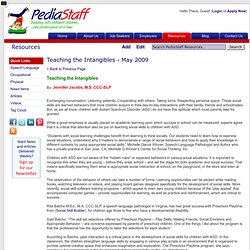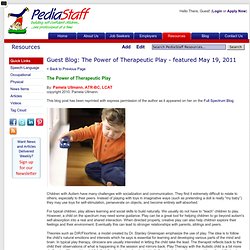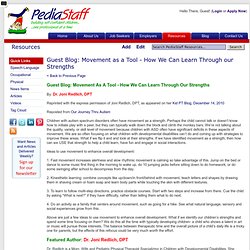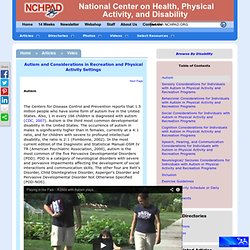

Topic Center - News - May Institute. Occupational and Physical Therapy Can Help Children with Autism Categories: ASD and DD, Child-focused Question What role do occupational and physical therapists play in developing treatment programs for children with autism?

Answer By Alan Harchik, Ph.D., BCBA Occupational and physical therapists provide services to many children with autism. Occupational therapy (OT) focuses upon either the development of new skills or the re-learning of skills that may have been lost. Helping Children with Autism: Treatment Strategies and Parenting Tips.
A parent’s guide to autism treatment and support If you've recently learned that your child has or might have an autism spectrum disorder, you're probably wondering and worrying about what comes next.

No parent is ever prepared to hear that a child is anything other than happy and healthy, and a diagnosis of autism can be particularly frightening. You may be unsure about how to best help your child or confused by conflicting treatment advice. Or you may have been told that autism is an incurable, lifelong condition, leaving you concerned that nothing you do will make a difference.
While it is true that autism is not something a person simply "grows out of," there are many treatments that can help children learn new skills and overcome a wide variety of developmental challenges. Don’t wait for a diagnosis As the parent of a child with autism or related developmental delays, the best thing you can do is to start treatment right away.
Carly's Voice: Breaking Through Autism by Arthur Fleischmann with Carly Fleischmann. Autism Games. Resources - Teaching the Intangibles - May 2009. Teaching the Intangibles By: Jennifer Jacobs, M.S.

CCC-SLP Exchanging conversation. Listening patiently. Cooperating with others. While a great emphasis is usually placed on academic learning upon which success in school can be measured, experts agree that it is critical that attention also be put on teaching social skills to children with ASD. “Students with social learning challenges benefit from learning to think socially. Children with ASD are not aware of the “hidden rules” or expected behaviors in various social situations.
The observation of the behavior of others can take a number of forms. Rita Batcho M.Ed., M.A. Said Batcho, “The skill set selections offered by Preschool Playtime -- Play Skills, Making Friends, Social Emotions and Appropriate Behavior -- are concerns expressed by parents of preschool children. According to Batcho, peer interaction is a critical piece in the development of social skills for children with ASD. Resources - Motor Deficits in Children with Autism and Related Disorders - Featured June 18, 2010.
Motor Deficits in Children with Autism and Related Disorders By: Dr.

Joni Redlich, DPT, Joni Daichman, MSPT, Tracy Cueli-Dutil, DPT and Roberto Tuchman, M.D. This article original appeared on April 18, 2010 in Autism Spectrum Disorders. Paper presented at the Geneva Centre Internal Symposium on Autism, Toronto, Canada (October 2002) Resources - Guest Blog: The Power of Therapeutic Play - featured May 19, 2011. The Power of Therapeutic Play By: Pamela Ullmann, ATR-BC, LCAT copyright 2010.

Pamela Ullmann. This blog post has been reprinted with express permission of the author as it appeared on her on the Full Spectrum Blog. Resources - Guest Blog: Movement as a Tool - How We Can Learn Through our Strengths. Guest Blog: Movement As A Tool - How We Can Learn Through Our Strengths.

Resources - Guest Blog: Eye Contact / Social Referencing / Joint Attention / Thinking with our Eyes - featured June 20, 2011. Guest Blog: Eye Contact / Social Referencing / Joint Attention / Thinking with our Eyes By: Suzanne Herman, M.Ed., CCC-SLP Copyright April 2011.

Reprinted with the express permission of the author as it appeared on her weblog When dealing with Autism Spectrum Disorders, the terms "eye contact, social referencing, and joint attention" are often part of the discussion. These terms all indicate a very similar skill involved in typical development. Eye contact is a term often seen in treatment goals for children with ASD. Joint attention develops in children between the ages of 9-12 months. Social referencing involves looking to a significant person in order to gage one's own emotional response. Michelle Winner's work gave me a better understanding of what was needed in addressing this area and how to go about achieving the goals. Autism Spectrum Disorders and Physical Therapy: The Motor Connection. Originally published in Autism Spectrum, Winter 2005 Movement is an integral part of our social, emotional, and physical lives.

A 4-month old excitedly kicks her arms and legs in response to the funny face dad makes, so he does it again. An 8-month old will crawl to retrieve her favorite rattle, shake it to hear the sound it makes, and then look at mom to share the experience with her. An 18 month-old takes moms hand, walks her to the kitchen, and says “juice” while pointing to the refrigerator. As a child grows, the length and complexity of movement sequences become more sophisticated. Children with autism spectrum disorder (ASD) often cannot coordinate the myriad of movements needed to complete these interactions. Motor differences are often due to motor planning challenges, sensory processing differences, atypical reflex development and underlying decreased tone.
During a Physical Therapy Evaluation a child’s neuromuscular, musculoskeletal, and cardiopulmonary systems are assessed. Resources - “Hands-on” Learning for ASD Through Visual and Creative Modalities. “Hands-on” Learning for ASD Through Visual and Creative Modalities By: Pamela Ullmann, ATR-BC, LCAT copyright 2010.

Pamela Ullmann. This blog post has been reprinted with express permission of the author as it appeared on her Full Spectrum Blog. NCHPAD : Autism and Considerations in Recreation and Physical Activity Settings. Autism The Centers for Disease Control and Prevention reports that 1.5 million people who have some form of autism live in the United States.

Also, 1 in every 166 children is diagnosed with autism (CDC, 2007). Autism is the third most common developmental disability in the United States. The occurrence of autism in males is significantly higher than in females, currently at a 4:1 ratio, and for children with severe to profound intellectual disability, the ratio is 2:1 (Fombonne, 2002). In the most current edition of the Diagnostic and Statistical Manual-DSM IV TR (American Psychiatric Association, 2000), autism is the most common of the five Pervasive Developmental Disorders (PDD). Autism is a spectrum of conditions of neurobiological origin unrelated to parental nurturance with no known cause.
Presently there are no medical or biological tests to diagnose autism. Resources - 7 Simple Ways to Improve Your Child’s Language Skills - featured April 8, 2011. 7 Simple Ways to Improve Your Child’s Language Skills Copyright © Autism Asperger’s Digest. 2011. All Rights Reserved. Editor's Note: This article is written for parents. We reprint it here so that you may share it with the parents of your kiddos.
Excerpted from the article, “Breaking the Language Barrier” that appears in the March/April 2011 issue of Autism Asperger’s Digest magazine. Language and communication – we use them to get our needs met, express ourselves and bond with others. Some easy ways I discovered to improve communication with (my son) Brett follow. Attention First and foremost, before you try to communicate with your child, before you try to teach him anything, get his attention.